NCERT Solutions Class 9 Maths
Chapter – 1 (Number Systems )
The NCERT Solutions in English Language for Class 9 Mathematics Chapter – 1 Number Systems Exercise 1.3 has been provided here to help the students in solving the questions from this exercise.
Chapter 1: Number Systems
- NCERT Solution Class 9 Maths Ex – 1.1
- NCERT Solution Class 9 Maths Ex – 1.2
- NCERT Solution Class 9 Maths Ex – 1.4
- NCERT Solution Class 9 Maths Ex – 1.5
- NCERT Solution Class 9 Maths Ex – 1.6
Exercise – 1.3
1. Write the following in decimal form and say what kind of decimal expansion each has :

Answer –
(i)
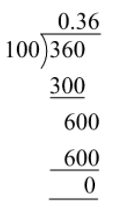
= 0.36 (Terminating)
(ii)

= 0.0909… = (Non Terminating and repeating)
(iii) =
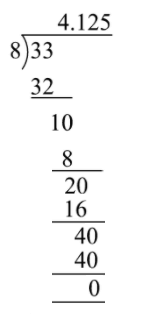
= 4.125 (Terminating)
(iv)
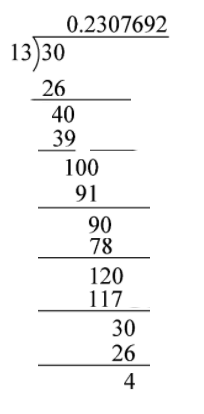
= 0.230769… = (Non Terminating and repeating)
(v)
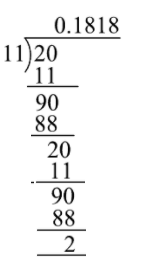
= 0.1818… = (Non Terminating and repeating)
(vi)

= 0.8225 (Terminating)
2. You know that =
Can you predict what the decimal expansions of
are, without actually doing the long division? If so, how?
[Hint: Study the remainders while finding the value of carefully.]
Answer –
2 ×
=
3 ×
=
4 ×
=
5 ×
=
6 ×
=
3. Express the following in the form , where p and q are integers and q ≠ 0.
(i)
(ii)
(iii)
Answer –
(i) = 0.666..
Assume that x = 0.666… ————- (i)
Multiplying both sides of the equation (i) by 10,
Then,
10x = 6.666… ————- (ii)
Subtracting the equation (i) from (ii),
10x = 6.666…
– x = 0.666…
9x = 6
Therefore, x =
So, the decimal number becomes
=
and it is in the required
form.
(ii) = 0.47777…..
Assume that x = 0.4777… ————- (i)
Multiplying both sides of the equation (i) by 10,
Then,
10x = 4.777… ————- (ii)
Subtracting the equation (i) from (ii),
10x = 4.777…
– x = 0.4777…
9x = 4.3
Therefore, x = =
×
=
So, the decimal number becomes
=
and it is in the required
form.
(iii) = 0.001001…
Assume that x = 0.001001… ————- (i)
Multiplying both sides of the equation (i) by 1000,
Then,
Then, 1000x = 1.001001… ————- (ii)
Subtracting the equation (i) from (ii)
1000x = 1.001001..
– x = 0.001001
999x = 1
Therefore, x =
So, the decimal number becomes
=
and it is in the required
form.
4. Express 0.99999…. in the form . Are you surprised by your answer? With your teacher and classmates discuss why the answer makes sense.
Answer – Assume that x = 0.9999 ….. ————– (i)
Multiplying both sides by 10,
10x = 9.9999…. ————– (ii)
Subtracting the equation (i) from (ii)
10x = 9.9999..
– x = 0.9999..
9x = 9
Therefore, x = 1
The difference between 1 and 0.999999 is 0.000001 which is negligible.
Hence, we can conclude that, 0.999 is too much near 1, therefore, 1 as the answer can be justified.
5. What can the maximum number of digits be in the repeating block of digits in the decimal expansion of ? Perform the division to check your answer.
Answer –
Dividing 1 by 17:
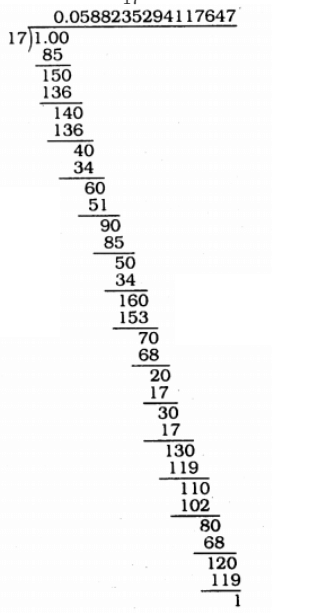
=
There are 16 digits in the repeating block of the decimal expansion of .
6. Look at several examples of rational numbers in the form (q ≠ 0), where p and q are integers with no common factors other than 1 and having terminating decimal representations (expansions). Can you guess what property q must satisfy?
Answer – We observe that when q is 2, 4, 5, 8, 10… Then the decimal expansion is terminating.
For example:
= 0. 5, denominator q = 21
= 0. 875, denominator q =23
= 0. 8, denominator q = 51
We can observe that the terminating decimal may be obtained in the situation where prime factorization of the denominator of the given fractions has the power of only 2 or only 5 or both.
7. Write three numbers whose decimal expansions are non-terminating non-recurring.
Answer – We know that all irrational numbers are non-terminating non-recurring. three numbers with decimal expansions that are non-terminating non-recurring are:
√2 = 1.41421….
√3 = 1.73205….
√7 = 2.645751….
8. Find three different irrational numbers between the rational numbers and
.
Answer – Converting and
into the decimal form gives
= 0.714285…..
= 0.818181…..
Therefore, 3 irrational numbers that are contained between 0.714285….. and 0.818181….. are:
0.73073007300073000073…, 0.75075007300075000075… and 0.76076007600076000076…
9. Classify the following numbers as rational or irrational according to their type:
(i)
(ii)
(iii) 0.3796
(iv) 7.478478
(v) 1.101001000100001…
Answer –
(i) = 4.79583152331…
Since the number is non-terminating and non-recurring therefore, it is an irrational number.
(ii) = 15 =
Since the number can be represented in form, it is a rational number.
(iii) 0.3796
Since the number,0.3796, is terminating, it is a rational number.
(iv) 7.478478
The number,7.478478, is non-terminating but recurring, it is a rational number.
(v) 1.101001000100001…
Since the number,1.101001000100001…, is non-terminating non-repeating (non-recurring), it is an irrational number.

Leave a Reply